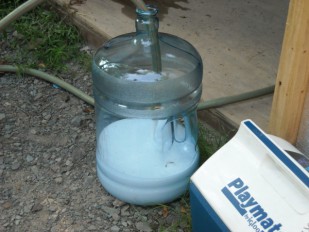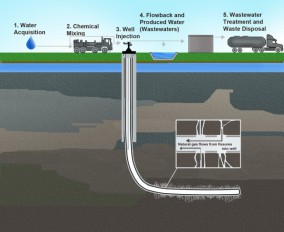Study Finds Fracking May Affect Air Quality Also

A new study published by scientists at the University of Oregon and University of CIncinnati concludes that people living and working proximate to fracking actively may well be exposed to certain pollutants at higher levels than considered safe for lifetime exposure according to the EPA. These pollutants, PAHs (polycyclic aromatic hydrocarbons), which are released as a byproduct of fracking are linked to increased risk of cancer and respiratory illness.
A new study published by scientists at the University of Oregon and University of CIncinnati concludes that people living and working proximate to fracking actively may well be exposed to certain pollutants at higher levels than considered safe for lifetime exposure according to the EPA. These pollutants, PAHs (polycyclic aromatic hydrocarbons), which are released as a byproduct of fracking are linked to increased risk of cancer and respiratory illness.
“Air pollution from fracking operations may pose an under-recognized health hazard to people living near them,” said Kim Anderson, an environmental chemist from OSU and a coauthor of the study. The scientists collected air samples from sites near active fracking wells from Carrol County, Ohio, a hotspot for natural gas. In fact, it was the citizens of Carrol County who first approached the University of Cincinnati requesting information about the health hazards of fracking in the area with more than one active well site per square mile. Twenty-three of these citizens volunteered the use of their land for the study. Sample sites ranged from directly adjacent to a well to over three miles away.
The samplers, aluminum T-shaped boxes containing specially treated polyethylene ribbons, detected high levels of PAHs from across the study area. As expected, concentrations of the pollutant were highest closest to the wells. Concentrations decreased by around thirty percent with distance. Even the lowest concentrations, detected on sites more than a mile away from the wells, were tenfold higher than those in areas without natural gas wells.
Even when accounting for PAH sources such as wood smoke and vehicle exhaust, the scientists were able to determine that the PAHs came directly from the earth or from the burning of fossil fuels. The researchers then applied a standard calculation for additional cancer risk which ranged a variety of exposure scenarios - the worst case scenario of constant exposure for 25 years meant a risk well exceeding the threshold set by the EPA.
The study has its caveats, using only a small number of non-random samples. Additionally this information is not necessarily applicable to other sites as PAH emissions are highly dependent on extraction techniques and underlying geography.
Source: University of Oregon
Source: University of Oregon
Want to read more like this story?

Living near major roads leads to high pollution exposure
Dec, 19, 2019 | NewsAccording to a new study, people living near major roads are exposed to high concentrations of air p...

Google Street View cars used for high-resolution air pollution mapping
Jun, 12, 2017 | NewsThis new approach towards urban air pollution mapping offers much greater spatial precision in compa...

Penn State Researchers Develop New Technique for Identifying Shale-drilling Additives in Drinking Water
May, 04, 2015 | NewsResearchers at Penn State University have developed a new analytical technique for identifying commo...

New study suggests sea level rise will be much worse than anticipated
Nov, 18, 2019 | NewsNew evidence suggest that sea water level will rise much faster than anticipated and will soon affec...

Horror Scenario For Coastal Areas
Jul, 29, 2015 | NewsClear warning from scientists, who note that the sea level rise may not be avoided even if the gover...

Indoor pollution: a widely overlooked problem
May, 10, 2016 | NewsScientists propose the use of real-time sensors of indoor air-quality for the battle against the Sic...

EPA Adds Five, Proposes Three Hazardous Waste Sites to Superfund’s National Priorities List
Sep, 25, 2014 | NewsToday, the U.S. Environmental Protection Agency (EPA) is adding five hazardous waste sites that pose...

New efficient laboratory test to determine soil productivity
Aug, 02, 2018 | NewsScientists at The Ohio State University and Cornell University have found a way to measure the healt...

Water storage after fracking related to seismic hazard
Dec, 13, 2018 | NewsNew study shows that the storage of water produced from oil and gas exploitation using hydrauli...
Trending

Vertical gardens in Mexico City to combat pollution

Saudi Park Closed After 360 Big Pendulum Ride Crashes to Ground, 23 injured

Characteristics of Load Bearing Masonry Construction

Taipei 101’s impressive tuned mass damper

Dutch greenhouses have revolutionized modern farming

Federal court rules Biden’s offshore drilling ban unlawful


